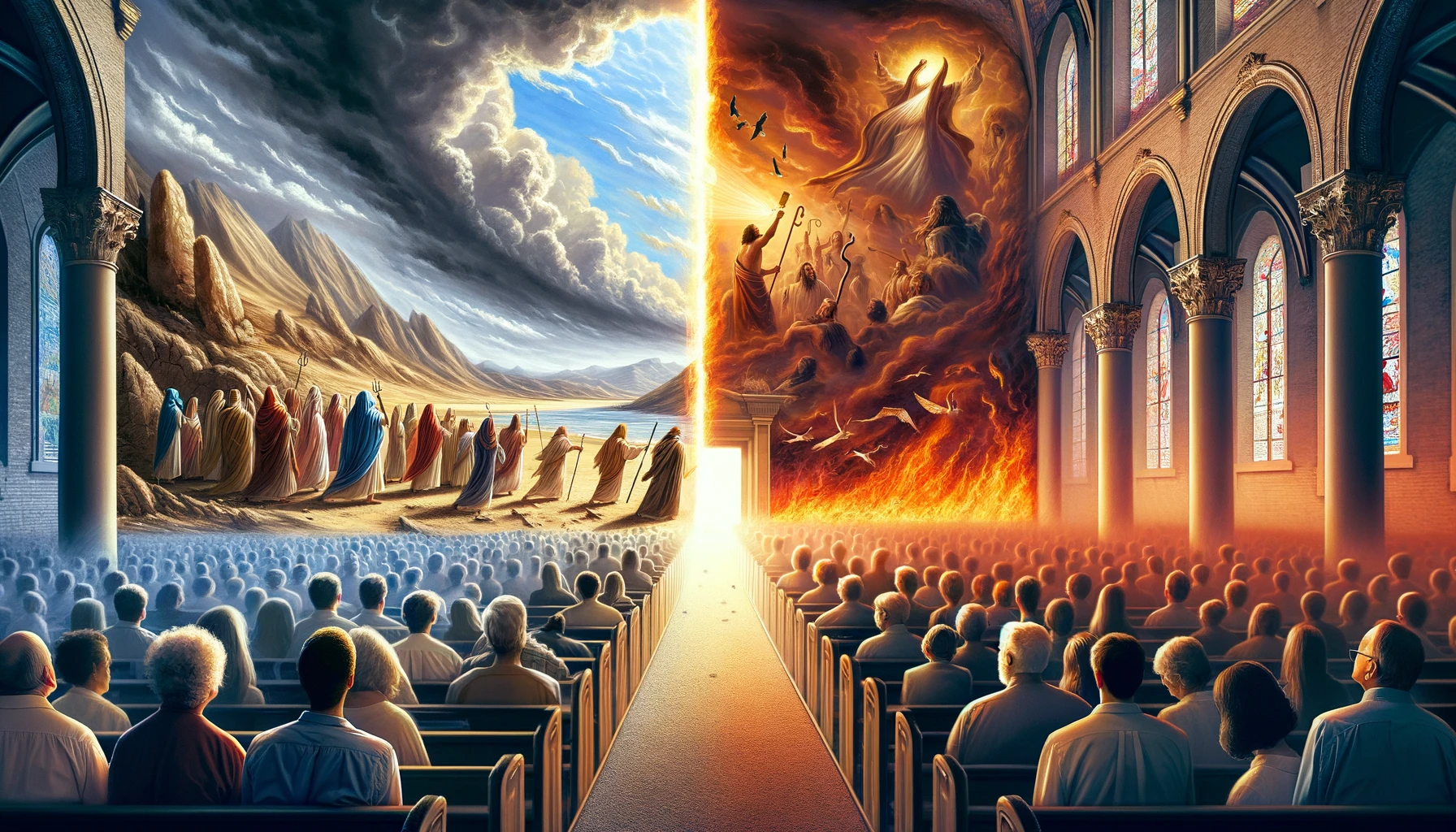How does faith sustain itself in the shadow of departing miracles? This blog post explores the intriguing parallel between the ancient Israelites, who faced a spiritual vacuum after the cessation of dramatic signs like manna and the pillar of cloud, and modern Christians, who might feel disconnected in the absence of overt supernatural events. We delve into the historical narrative to uncover how the loss of visible divine acts could lead to the allure of idolatry and occult practices, offering vital lessons for today’s church and believers.
As we trace the journey of the Israelites from the awe-inspiring plagues of Egypt through their wilderness wanderings marked by divine guidance to their eventual settlement in Canaan, a pattern emerges: when overt signs of God’s presence wane, the temptation towards alternative spiritual practices grows. This blog post examines how this historical precedent might reflect in contemporary Christian contexts, where diminishing palpable miracles could subtly encourage a drift towards idolatrous or occult inclinations. By understanding this dynamic, we can better navigate our spiritual disciplines and community practices to maintain a robust faith grounded not in the seen but in the unseen.
Let’s begin with laying the foundation.
Israel was oppressed for over 400 years under their Egyptian masters (Exodus 1:11-14). When Moses and Aaron came and demanded that Pharaoh let the people of God go (Exodus 5:1), the offspring of Abraham, Isaac, and Jacob saw God’s power in the form of the Ten Plagues (Exodus 7-12). When Israel was “cornered” at the Red Sea facing destruction, they witnessed the parting of the waters, which led them to safety (Exodus 14:21-31) and the destruction of Pharaoh’s army by the hand of God (Exodus 14:27-28). Putting aside the golden calf incident at Mount Siani (Exodus 32:1-8), that generation saw signs and wonders that provided their escape from bondage throughout their 40-year wandering in the desert (Numbers 14:22-23 – more on that later). Since God judged the older generation unworthy to see the promised land (Numbers 26:64-65), a new generation (Deuteronomy 1:35-39) grew up only knowing about the daily signs, wonders, and nomadic life.
What the two generations saw during the 40 years.
During the Israelites’ 40-year journey in the wilderness, as described in the books of Exodus, Numbers, and Deuteronomy in the Hebrew Bible, several supernatural manifestations were consistently present, signifying God’s guidance and support. These include:
- Pillar of Cloud and Fire: God guided the Israelites by a pillar of cloud by day and a pillar of fire by night to show them the way they should go (Exodus 13:21-22).
- Manna: God provided manna, a miraculous food, which fell from heaven six days a week to feed the Israelites throughout their wilderness journey (Exodus 16:35).
- Water from Rock: At different times when the Israelites needed water, God instructed Moses to strike or speak to a rock, from which water miraculously flowed (Exodus 17:6; Numbers 20:11).
These manifestations of divine intervention were vital for the Israelites’ survival and guidance throughout their wilderness experiences and served as tangible signs of God’s presence and care.
The Tabernacle
The Tabernacle, also known as the Tent of Meeting, was another significant supernatural element associated with the Israelites during their 40 years in the wilderness. It served as a portable earthly dwelling place of God among His people. Here are a few aspects that highlight its supernatural and divine significance:
- Divine Instruction and Design: The Tabernacle was constructed according to detailed instructions given by God to Moses on Mount Sinai (Exodus 25–31). These instructions covered everything from layout to materials, emphasizing that the Tabernacle was divinely ordained.
- Manifestation of God’s Glory: Once the Tabernacle was erected and consecrated, the glory of the Lord filled it in a visible manifestation of His presence among the Israelites (Exodus 40:34-35). This phenomenon was a supernatural sign that God was dwelling among His people.
- Central Place of Worship and Sacrifice: The Tabernacle was the center of religious life for the Israelites in the wilderness. It housed the Ark of the Covenant and was the place where priests performed sacrifices and other rituals to atone for the people’s sins and maintain the covenant relationship with God.
- Guidance on Movement: The movement of the Israelites through the desert was directly connected to the presence of the Tabernacle. They set up and broke camp based on the cloud over the Tabernacle. The Israelites would set out when the cloud lifted from the Tabernacle; when the cloud stopped, they encamped (Numbers 9:17-23).
The Tabernacle symbolizes God’s immediate presence and ongoing guidance, protection, and provision. It was a tangible expression of God’s commitment to dwell among His people and lead them to the Promised Land.
The Angel
In the biblical narrative, an angel is indeed mentioned among the Israelites during their journey and after entering the Promised Land. The key passages that discuss the presence of an angel provide insight into his purpose and involvement with the Israelites.
Purpose of the Angel
- Guidance and Protection: In Exodus 23:20-23, God tells Moses about sending an angel ahead of the Israelites to guard them along the way and to bring them into the place He has prepared. This angel’s purpose includes protecting them from physical dangers and leading them through the challenging wilderness to the Promised Land.
- Enforcing Covenant Faithfulness: The angel is also tasked with keeping the Israelites on the path of covenant faithfulness. God warns the Israelites to obey this angel and not to rebel against him because he will not pardon their transgressions; he carries God’s authority.
Presence of the Angel
The duration of the angel’s stay with the Israelites is not explicitly detailed in terms of a specific timeline. However, several points can be inferred:
- Throughout the Wilderness Journey: Exodus implies that the angel would be with them throughout their travels in the wilderness, ensuring their safe passage and adherence to God’s commands.
- Into the Promised Land: In Exodus 32:34 and 33:2, even after the incident of the Golden Calf, God mentions that He would send an angel to lead the people to the Promised Land. This indicates the angel’s presence continued at least into the initial phase of entering Canaan.
- Ongoing Divine Interaction: While the specific mention of the angel becomes less frequent, the divine interaction with Israel through various agents – whether angels, prophets, or judges – continues throughout the biblical narrative. The concept of an angelic guide or protector does not entirely disappear and reappears in various forms, such as the angel appearing to Balaam in Numbers 22 or to the parents of Samson in Judges 13.
The biblical text thus suggests that the angel played a crucial role during critical phases of Israel’s formation and journey, primarily focusing on guidance, protection, and the enforcement of divine directives. His presence was implied as long as necessary to achieve these aims. The angel’s specific actions and God’s messages through him underscore the seriousness of the covenant and the need for the Israelites’ obedience.
The change. The promised land, Joshua, and the loss of signs and wonders.
When the Israelites entered the Promised Land, several significant changes occurred concerning the supernatural manifestations they had experienced in the wilderness. Here are the primary transitions:
- Pillar of Cloud and Fire: The pillars of cloud and fire, which had guided the Israelites through the wilderness, are no longer mentioned after the crossing of the Jordan River. Their guidance was no longer necessary in the same way as the Israelites had reached their destination.
- Manna: The manna ceased once the Israelites entered Canaan. The Bible specifically states that the manna stopped the day after they ate the produce of the land; there was no longer any manna for the Israelites, and they ate the crops of Canaan from that year onward (Joshua 5:12).
- Water from the Rock: The miraculous provision of water from the rock ceased as they entered a land with natural resources, including water sources, which could support their population through agriculture and natural means.
- The Tabernacle: The Tabernacle continued to be significant in the early years in Canaan, serving as the central place of worship. Initially set up at Gilgal (Joshua 4:19), it was later moved to Shiloh where it remained for a considerable period (Joshua 18:1). The Tabernacle stayed the focal point of Israelite worship until the construction of Solomon’s Temple in Jerusalem.
These changes reflect a shift from a nomadic, survival-based lifestyle under direct divine intervention to a more settled existence relying on the natural bounty of the land and established religious practices centered around the Tabernacle. The transition into the Promised Land marked a new phase in the relationship between God and the Israelites, focusing more on living according to the covenant in the land God had promised to their ancestors.
The Bible does not provide a specific verse that explicitly states the cessation of the pillar of cloud and fire upon the Israelites’ entrance into the Promised Land. The narrative simply shifts away from mentioning these guiding phenomena once the Israelites cross the Jordan River and begin the conquest and settlement of Canaan.
The last reference to the pillar of cloud and fire is in the context of the Israelites’ wilderness journeys. For instance, Numbers 9:15-23 describes in detail how the cloud covered the Tabernacle, representing God’s presence, and how it guided their movements: rising from the Tabernacle to signal when they should set out and settling back over it when they should stop and encamp. These passages emphasize the role of the cloud and fire in directing the Israelites throughout their wanderings.
After crossing the Jordan River, the narrative focus in the book of Joshua shifts to the conquests and distribution of the land among the tribes of Israel, and the miraculous guidance of the cloud and fire is no longer mentioned. This absence can be interpreted as their cessation, which fits the change in the Israelites’ needs and circumstances. Now settled in a specific territory, the form of divine guidance they required shifted from nomadic journeying to settling and thriving in the land, underpinned by the covenant and the Law, and later through prophets and leaders.
What happened to God in the Tabernacle? Was He still present in the same way?
After the Israelites entered the Promised Land, God’s glory in the Tabernacle continued, albeit with a shift in how His guidance was manifested. The Bible indicates that the glory of the Lord, which initially filled the Tabernacle upon its completion and dedication in the wilderness (Exodus 40:34-35), remained an enduring symbol of God’s presence among His people.
God’s Glory in the Tabernacle
In the Promised Land, the Tabernacle was initially set up at Gilgal, but later, it was moved to Shiloh. Although the specific mentions of God’s glory filling the Tabernacle as vividly as in the wilderness are less frequent, it is implied that His presence remained with the Ark of the Covenant, which was housed within the Tabernacle. This continued presence signified God’s ongoing relationship and covenant with Israel.
Guidance of God
The nature of God’s guidance did evolve:
- Prophetic Leadership: After Joshua’s leadership, guiding the people shifted more prominently to the judges and prophets. Figures like Samuel, who ministered before the Lord at Shiloh, where the Tabernacle and the Ark were (1 Samuel 3:1-21), played crucial roles in guiding the Israelites spiritually and politically.
- Direct Interventions and Instructions: While the overt guidance through the pillars of cloud and fire ceased, God intervened directly in Israel’s affairs through various means, including theophanies, dreams, and angels. For example, God’s communications with Gideon and Samson’s parents (Judges 6:11-40; Judges 13) demonstrate His ongoing involvement.
- Covenantal and Legal Guidance: Moses’s laws and commandments continued to guide the Israelites in their daily lives and religious observances. This body of law directed the community’s moral, social, and religious life.
Even though the dynamic manifestations of God’s guidance in the wilderness (such as the cloud and fire) were no longer present in the same form, God’s guidance and His glory did not depart from Israel. The transition into a settled life in Canaan brought about different forms of divine interaction, focusing on a settled community living under the laws given at Sinai and led by a succession of leaders raised by God according to the needs of the people.
Joshua
The book of Joshua covers a period of approximately 25 to 30 years. This estimate includes the initial crossing of the Jordan River, the conquest of the land of Canaan, and the subsequent division and settlement of the territories among the twelve tribes of Israel.
The narrative begins with preparing to enter Canaan shortly after Moses’s death. It concludes with the death of Joshua and a summary of the Israelites’ situation in their new homeland. The exact number of years is not specified in the text itself, but scholars generally agree on this timeframe based on the events described and the sequence of leadership transitions. The timeline includes the initial battles to conquer the land, the time taken to distribute the land among the tribes, and the relative peace and consolidation period towards the end of Joshua’s life.
Joshua…connection between the old and new generations
Joshua was one of the original Israelites led out of Egypt. He would have witnessed the plagues, the crossing of the Red Sea, the events at Mount Sinai, and the subsequent wandering in the desert. Here are a few key points that highlight his involvement and presence during these foundational events in Israelite history:
- Spying on Canaan: Joshua first appears prominently in the biblical narrative as one of the twelve spies sent by Moses to scout the land of Canaan. At this time, he is identified as an assistant to Moses and a leader of the tribe of Ephraim (Numbers 13:8, 16).
- At Mount Sinai: While not explicitly mentioned during the events at Mount Sinai, Joshua’s close association with Moses throughout the wilderness journey suggests his presence during significant moments like the giving of the Law.
- Military Leader: Joshua’s military leadership began before entering Canaan. One notable instance is his role as the commander in the battle against the Amalekites shortly after leaving Egypt, which took place in the Rephidim following the crossing of the Red Sea (Exodus 17:8-16).
- Moses’ Protégé: Joshua was described as Moses’ aide from his youth (Numbers 11:28), indicating his long-term close proximity to Moses, including during critical moments and decisions throughout the journey in the wilderness.
- Transition of Leadership: Joshua was appointed as Moses’ successor before Moses’ death. This was done at God’s command, indicating divine approval of Joshua’s faithfulness and leadership capabilities (Numbers 27:18-23).
These references underscore Joshua’s integral role in the Exodus from Egypt through the conquest of Canaan, marking him as a witness to and participant in all the major events experienced by the generation that left Egypt under Moses’ leadership.






